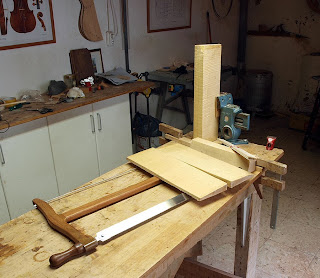Heres the sides and neck ready for assembly. The sides have inner linings and the heel of the neck has been prepared for the sides. The final shapening of the neck and the linings of the sides. Will be done later on.
jueves, 28 de noviembre de 2013
lunes, 25 de noviembre de 2013
jueves, 21 de noviembre de 2013
martes, 19 de noviembre de 2013
domingo, 17 de noviembre de 2013
sábado, 16 de noviembre de 2013
starting up the sides
The first thing to do when starting the the sides is to make and fit the corner blocks and the top and bottom block. Here ther are being glued to the mold.
miércoles, 13 de noviembre de 2013
jueves, 7 de noviembre de 2013
110 finished
#110 is a 2A blanca. 650mm scale, 52mm nut width and finish is French Polish.
The back and sides are what is called silver oak (grevillea robusta) I dont like to use the common name as it creates confusion. Most think its heavy and in family with oak, which is not true. Silver oak is an Australian evergreen much closer to cypress than anything else. The only thing it has in common with oak is the figuring of the wood when perfectly quatersawn.
In fact, when I thicknessed the back, I did so together with a top grade piece of cypress and I ended up with the same thickness, stiffness and weight and a tap tone just a hair below the taptone of the cypress. And it sounds and feels like cypress. And it looks very good in my opinion.
I will not build more 2A guitars with this wood. I will reserve it for special 1A projects.
The back and sides are what is called silver oak (grevillea robusta) I dont like to use the common name as it creates confusion. Most think its heavy and in family with oak, which is not true. Silver oak is an Australian evergreen much closer to cypress than anything else. The only thing it has in common with oak is the figuring of the wood when perfectly quatersawn.
In fact, when I thicknessed the back, I did so together with a top grade piece of cypress and I ended up with the same thickness, stiffness and weight and a tap tone just a hair below the taptone of the cypress. And it sounds and feels like cypress. And it looks very good in my opinion.
I will not build more 2A guitars with this wood. I will reserve it for special 1A projects.
miércoles, 6 de noviembre de 2013
#112 finished
Here´s number 112, a 1A Blanca with wooden pegs. scale is 660 and nut width is 53mm. Finish is French polish.
The guitar is for sale
The guitar is for sale
martes, 5 de noviembre de 2013
111 finished
A 2A negra with Padauk/coral back and sides. Very percussive and flamenco. Its for sale. (2000,-€)
650mm scale and 52mm nut. Finish is French polish.
650mm scale and 52mm nut. Finish is French polish.
domingo, 3 de noviembre de 2013
Installing "pegheds" tip
Hi
Just a photo I made when installing a set of mechanical pegs from pegheds.com
The installation instructions say that we should drill a 7mm hole and ream the hole to a size so that the pegs are a few milimeters from going all the way through to their final position.
We are then supposed to "cut" a thread in the headstocks wood by turning in the peg and using the threaded shaft of the peg to do the cutting. We shall turn the shaft of the peg and never turn the head of the peg.
This turning and cutting the thread can be hard for our fingers, so it helps to turn a rubberband around the shaft. As simple as that. My fingers not as good as they were and these little tips help a lot.
I didn´t find out this by myself, but because I recently installed a set of "pegheds" on a fiddle and the instructions for the pegs said to do use a rubberband. Violin pegs are smaller, meaning that its more difficult to get a good grip on the peg shaft and besides that, you have to cut the thread in maple which is a lot harder than the Spanish cedar used on flamenco guitars.
The guitar is number 109.
Just a photo I made when installing a set of mechanical pegs from pegheds.com
The installation instructions say that we should drill a 7mm hole and ream the hole to a size so that the pegs are a few milimeters from going all the way through to their final position.
We are then supposed to "cut" a thread in the headstocks wood by turning in the peg and using the threaded shaft of the peg to do the cutting. We shall turn the shaft of the peg and never turn the head of the peg.
This turning and cutting the thread can be hard for our fingers, so it helps to turn a rubberband around the shaft. As simple as that. My fingers not as good as they were and these little tips help a lot.
I didn´t find out this by myself, but because I recently installed a set of "pegheds" on a fiddle and the instructions for the pegs said to do use a rubberband. Violin pegs are smaller, meaning that its more difficult to get a good grip on the peg shaft and besides that, you have to cut the thread in maple which is a lot harder than the Spanish cedar used on flamenco guitars.
The guitar is number 109.
Suscribirse a:
Entradas (Atom)


























